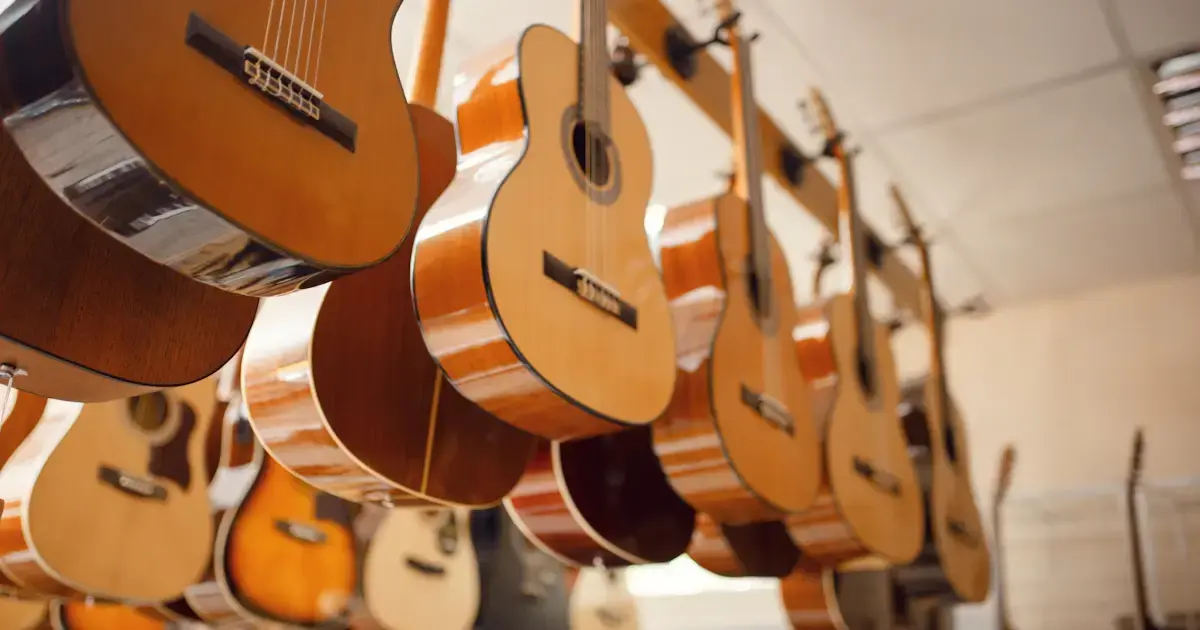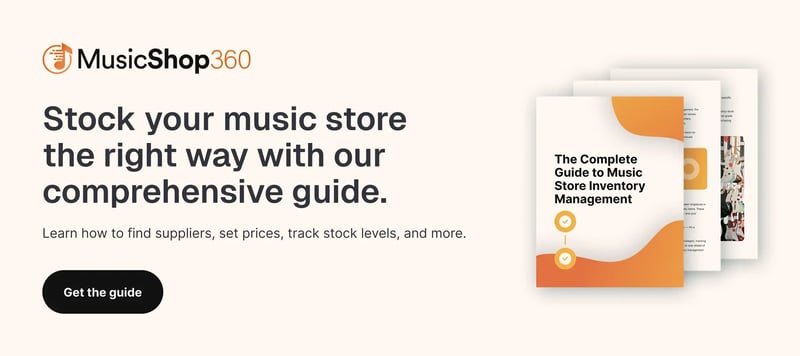
For a music store to truly stand out, it needs a great design.
As a music store owner, you know that to succeed in the industry, you need high-quality musical instruments and top-notch customer service — but music shop design is an easily overlooked aspect of the business. Great music shop design catches the eyes of customers and makes your brand recognizable, leading to increased sales.
In this blog, we’ll focus on common interior and exterior design mistakes to avoid in your music shop. These errors can detract from a customer’s experience or be a missed opportunity to gain a new customer.
By consciously avoiding these issues, you can create a unique, interesting store design that increases foot traffic, improves retention, and ensures your success.
1. Ignoring Store Layout
Picture this: You walk into a cluttered, disorganized retail store. There are no clear sections and the placement of products seems random and scattered. Do you expect to find something great here? Probably not.
Customers want a store to be organized into clear sections so it’s easy to find what they’re looking for. If your music store sells a variety of instruments, you can create sections for individual instruments and instrument types — like woodwind, brass, percussion, and strings. If you specialize in one instrument like pianos or guitars, you can create sections for different brands or for different instrument styles — like acoustic or electric guitars.
Try to chart a clear path through your music store for customers. For example, you might place instrument accessories like carrying cases or guitar pics and capos between guitars and the register, so your customers can get the accessories they need before they make their final purchases. The more logical your store’s layout is, the more customers will browse and the more purchases they’ll make.
Related Read: 7 Inspiring Music Shop Interior Design Ideas
2. Lighting Your Music Store Poorly
Lighting has a great effect on your music store’s environment. Lighting that’s overly dim obscures a customer’s view of products and makes it more difficult to browse. Lighting that’s overly bright might be irritating to a customer. Find a balanced lighting approach that makes it easy to see the entire store and highlights your top-selling products.
3. Neglecting Exterior Signage
Do you ever pass by a business without being able to tell what it is? Maybe the sign is too vague, or there isn’t any sign at all. Every customer that walks by your business or comes across its logo online should know it’s a music store. Create an eye-catching logo and a large sign to place above your doors to make this clear.
Attention spans are short — and they’re only getting shorter. If a sign is too small, too difficult to read, or too vague, passersby aren’t likely to give it a second look. Invest in signage that’s interesting, clear, and recognizable.
4. Overcrowding Shelves and Racks
Placing too many items too close together on shelves can make your music store seem cluttered, make it difficult for customers to find what they’re looking for, and can cause damage to musical instruments. Give enough space for each item, and if necessary, keep a few more instruments in the back before placing them on the shelves.
Giving adequate space between items, displays, and store sections makes your music store feel more open and makes the shopping experience easier for customers.
Related Read: Where Do Music Stores Get Their Inventory? + 5 Tips for Managing Yours
5. Underestimating the Power of Color
Color has a strong influence on the perception of your music store. A lack of color makes your store seem dull — but too many bright colors can be overwhelming and distracting. Selectively use accent colors to create a balanced and interesting environment.
The eye is drawn to bright colors, so you can use these colors as accents to draw customers to your top-selling items. Determine what your highest-selling items are and use bright colors around these items to highlight them. Even small details like these can help you increase sales.
6. Skimping on Branding Elements
Inconsistent or weak branding makes your music store less recognizable and causes it to blend into the competition. To create a strong brand, you need to determine what kind of music store it will be, and create a logo and visual language that’s cohesive across your entire business.
First, determine what kind of music store you want to run. Will you specialize in a specific instrument type — like pianos, guitars, or violins — or will you offer a wide variety of instruments? Will you specialize in high-end instruments for professional musicians, or offer low-cost instruments for students and other beginners? Once you make these decisions, you can begin developing your brand.
Your music store’s name, logo, and colors should match the kind of store it is. A low cost store might use bright colors, while a more high-end store is typically associated with more neutral colors. If you sell guitars, consider incorporating the image of a guitar or the word “guitar” in your logo. The clearer you can make your signage, the more brand awareness you can develop.
Remember: Effective branding leads to more customers, greater customer loyalty, and increased sales.
Related Read: 12 Fresh Ways To Amp Up Your Music Store Marketing
7. Overlooking Acoustics and Space
Many customers want to try playing an instrument in your music store before they buy it. To accommodate this, you need good acoustics and sufficient space. Invest in equipment that’ll improve acoustics in your store so instruments can be heard clearly. This also allows you to play light music in your store at a consistent volume and without echoes.
For musical instrument demos, you also need enough space. Add benches or other seating so customers can sit as they play a guitar or violin. Creating dedicated instrument demo areas helps ensure you always have adequate seating and space. If a customer can try out an instrument in your store, they’ll feel more confident in making a purchase.
8. Failing To Utilize Displays Effectively
Displays are useful in drawing attention to certain products. You may want to draw attention to your top sellers, or to instruments with lower sales. These displays should be placed in prominent locations in your music store, close to the front, as hiding displays too far into your store may cause them to be passed over. Don’t forget to organize these displays well.
Continually rotate displays to create variety. If the same product display stays for too long, interest may start to fade.
9. Disregarding the Checkout Experience
A poorly designed checkout area frustrates customers. To improve customer experience, you need to create a simple, seamless checkout process. During heavier shopping periods, you need space for a line to develop behind the registers — this way, your checkout line won’t block off access to aisles and displays.
Sales transactions should be quick and painless. To take quick payments from a variety of payment types, you need a point of sale (POS) system. The more payment types you can accept at your music store, the more customers you can serve and the faster you can move customers through.
Make sure the POS system you’re using can accept the following payment types:
- Cash
- Credit and debit cards
- Apple Pay
- Google Pay
As you set up the register at your music store, put yourself in your customers’ shoes to create a simple and fast checkout experience.
Related Read: 10 Must-Have POS Features for Music Stores
How To Create the Ideal Music Shop Design
Avoiding these design mistakes at your music store will improve customer experience, leading to more browsing and increased sales. A clear and logical store design with plenty of space, dedicated demo areas, recognizable branding, and adequate lighting will create the perfect environment for buying a musical instrument.
Over time, styles change and new trends emerge. Stay updated on what other music stores are doing and update your store from time to time based on market trends and new designs, so you can effectively compete in the industry.
But your music shop design isn’t complete without a POS system. In addition to providing a quick and simple checkout experience at the register, a POS system offers a variety of features to help you manage all of your music store’s operations. The best fit for your store is a POS system specifically designed for music stores: Music Shop 360.
Music Shop 360 is a cloud-based POS system that can be accessed from any web-enabled device. With features for inventory management, e-commerce, marketing, and more, you can manage your entire business from one spot.
To see Music Shop 360 for yourself, schedule a demo today!



 by
by 







